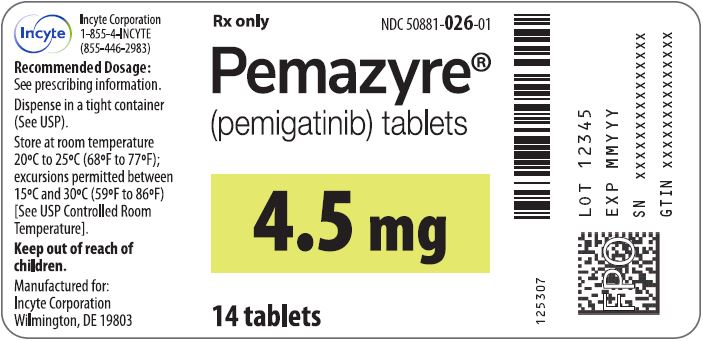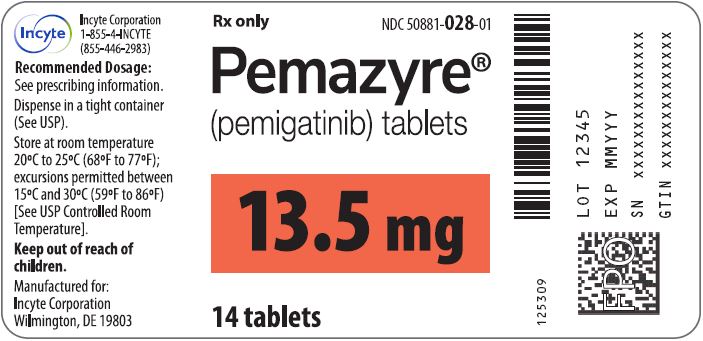Pemazyre
Generic name: pemigatinib
Drug class: Multikinase inhibitors
Medically reviewed by A Ras MD.
What is Pemazyre?
Pemazyre is a prescription medicine that is used to treat adults with bile duct cancer (cholangiocarcinoma) that has spread or cannot be removed by surgery who have already received a previous treatment, and whose tumor has a certain type of abnormal “FGFR2” gene.
Your healthcare provider will test your cancer for a certain type of abnormal FGFR2 gene and make sure that Pemazyre is right for you.
It is not known if Pemazyre is safe and effective in children.
Description
Pemigatinib is a kinase inhibitor with the chemical name 3-(2,6-difluoro-3,5-dimethoxyphenyl)-1-ethyl-8-(morpholin-4-ylmethyl)-1,3,4,7-tetrahydro-2H-pyrrolo[3′,2′:5,6]pyrido[4,3-d]pyrimidin-2-one. Pemigatinib has a molecular formula of C24H27F2N5O4 and molecular mass of 487.5 g/mole. Pemigatinib has the following chemical structure:

Pemigatinib is a white to off-white solid that is not hygroscopic. The solubility of pemigatinib is pH dependent with decreasing solubility observed with increasing pH. PEMAZYRE tablets are uncoated and for oral administration. Tablets are available containing 4.5 mg, 9 mg, or 13.5 mg of pemigatinib active ingredient. The inactive ingredients include magnesium stearate, microcrystalline cellulose, and sodium starch glycolate.
Mechanism of Action
Pemigatinib is a small molecule kinase inhibitor that targets FGFR1, 2 and 3 with IC50 values of less than 2 nM. Pemigatinib also inhibited FGFR4 in vitro at a concentration approximately 100 times higher than those that inhibit FGFR1, 2, and 3. Pemigatinib inhibited FGFR1-3 phosphorylation and signaling and decreased cell viability in cancer cell lines with activating FGFR amplifications and fusions that resulted in constitutive activation of FGFR signaling. Constitutive FGFR signaling can support the proliferation and survival of malignant cells. Pemigatinib exhibited anti-tumor activity in mouse xenograft models of human tumors with FGFR1, FGFR2, or FGFR3 alterations resulting in constitutive FGFR activation including a patient-derived xenograft model of cholangiocarcinoma that expressed an oncogenic FGFR2-Transformer-2 beta homolog (TRA2b) fusion protein.
What should I tell my healthcare provider before taking Pemazyre?
Before you take Pemazyre, tell your healthcare provider about all of your medical conditions, including if you:
- have vision or eye problems
- have problems swallowing tablets
- are pregnant or plan to become pregnant. Pemazyre can harm your unborn baby or cause loss of your pregnancy (miscarriage). You should not become pregnant during treatment with Pemazyre.
- Females who can become pregnant:
- Your healthcare provider should do a pregnancy test before you start treatment with Pemazyre.
- You should use an effective method of birth control during treatment and for 1 week after your final dose of Pemazyre. Talk to your healthcare provider about birth control methods that may be right for you.
- Tell your healthcare provider right away if you become pregnant or think that you may be pregnant.
- Males with female partners who can become pregnant:
- You should use effective birth control when sexually active during treatment with Pemazyre and for 1 week after your final dose of Pemazyre.
- Females who can become pregnant:
- are breastfeeding or plan to breastfeed.Do not breastfeed during treatment and for 1 week after your final dose of Pemazyre.
Tell your healthcare provider about all the medicines you take, including prescription and over-the-counter medicines, vitamins, and herbal supplements.
How should I take Pemazyre?
- Take Pemazyre exactly as your healthcare provider tells you.
- Pemazyre is taken in cycles of 21 days. Take Pemazyre 1 time each day for 14 days, followed by 7 days off treatment, to complete a 21-day treatment cycle.
- Take Pemazyre 1 time each day at about the same time each day.
- Take Pemazyre with or without food.
- Swallow tablets whole. Do not crush, chew, split, or dissolve Pemazyre tablets.
- You should not eat or drink grapefruit products during treatment with Pemazyre.
- Your healthcare provider may change your dose of Pemazyre, or may temporarily or completely stop treatment if you get certain side effects.
- If you miss a dose of Pemazyre, you can take the missed dose within 4 hours on the same day. If more than 4 hours have passed, do not make up the dose. Take your regular dose of Pemazyre the next day at the usual time. Do not take more Pemazyre than prescribed to make up for the missed dose.
- If you vomit after taking Pemazyre, do not take another Pemazyre tablet. Take your regular dose of Pemazyre the next day at the usual time.
What are the possible side effects of Pemazyre?
Pemazyre may cause serious side effects, including:
- Eye problems. Certain eye problems are common with Pemazyre but can also be serious. Eye problems include dry eye or inflamed eyes, inflamed cornea (front part of the eye), increased tears, and a disorder of the retina (an internal part of the eye). You will need to see an eye specialist for a complete eye exam before you begin treatment with Pemazyre, every 2 months for the first 6 months, and then every 3 months during treatment with Pemazyre.
- You should use artificial tears or substitutes, hydrating or lubricating eye gels as needed, to help prevent or treat dry eyes.
- Tell your healthcare provider right away if you develop any changes in your vision during treatment with Pemazyre, including: blurred vision, flashes of light, or see black spots. You may need to see an eye specialist right away.
- High phosphate levels in your blood (hyperphosphatemia). Hyperphosphatemia is common with Pemazyre but can also be serious. Your healthcare provider will check your blood phosphate levels during treatment with Pemazyre.
- Your healthcare provider may prescribe changes in your diet or phosphate lowering therapy, or change, interrupt or stop Pemazyre if needed.
- Tell your healthcare provider right away if you develop any muscle cramps, or numbness or tingling around your mouth.
The most common side effects of Pemazyre include:
- hair loss
- diarrhea
- nails separate from the bed or poor formation of the nail
- feeling tired
- change in sense of taste
- nausea
- constipation
- mouth sores
- dry eyes
- dry mouth
- decrease in appetite
- vomiting
- joint pain
- stomach-area (abdominal) pain
- low phosphate in blood
- back pain
- dry skin
These are not all the possible side effects of Pemazyre. For more information, ask your healthcare provider or pharmacist.
Call your doctor for medical advice about side effects. You may report side effects to FDA at 1‑800-FDA-1088.
General information about the safe and effective use of Pemazyre
Medicines are sometimes prescribed for purposes other than those listed in a Patient Information leaflet. Do not use Pemazyre for a condition for which it is not prescribed. Do not give Pemazyre to other people, even if they have the same symptoms you have. It may harm them. If you would like more information, talk with your healthcare provider. You can ask your pharmacist or healthcare provider for information that is written for healthcare professionals.
How should I store Pemazyre?
- Store Pemazyre at room temperature between 68°F to 77°F (20°C to 25°C).
Keep Pemazyre and all medicines out of the reach of children.
What are the ingredients in Pemazyre?
Active ingredient: pemigatinib
Inactive ingredients: magnesium stearate, microcrystalline cellulose, and sodium starch glycolate
Label
4.5 MG TABLET BOTTLE LABEL
- Rx only
- NDC 50881-026-01
- PemazyreTM (pemigatinib) tablets
- 4.5 mg
- 14 tablets

9 MG TABLET BOTTLE LABEL
- Rx only
- NDC 50881-027-01
- PemazyreTM (pemigatinib) tablets
- 9 mg
- 14 tablets

13.5 MG TABLET BOTTLE LABEL
